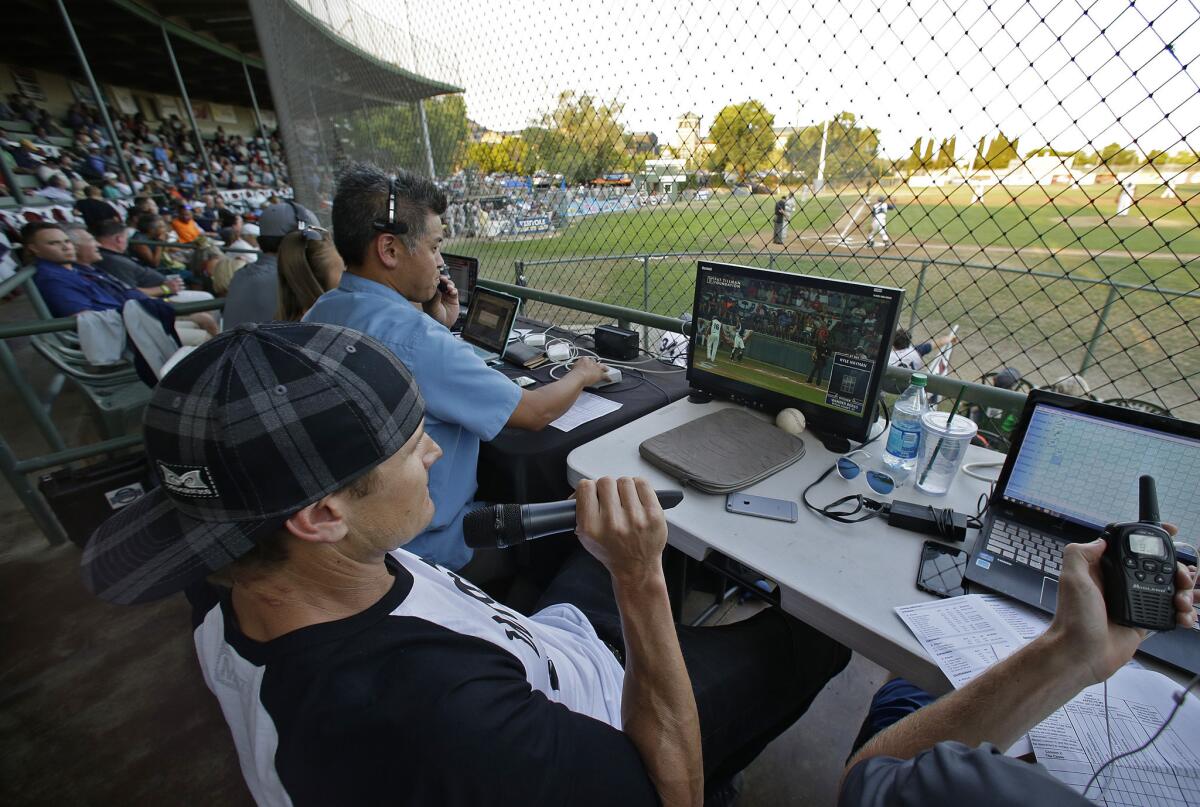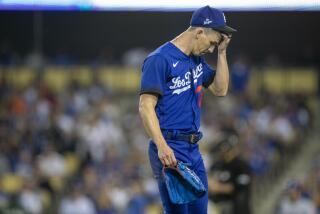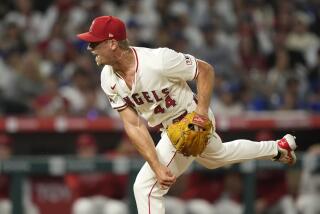Rise of the machines? Baseball weighs use of automated strike zone

Former major league outfielder Eric Byrnes advocates using a computerized video system to call balls and strikes. The three-camera system is being tested in the Independent League in Northern California.
Depending on whom you ask, professional baseball could be on the precipice of an important technological advancement, or it might be flirting with an âI, Robotâ-style takeover.
The San Rafael Pacifics and Vallejo Admirals, two independent (not major league-affiliated) minor league teams, recently played two games using a computer system, rather than the home plate umpire, to call balls and strikes.
The automated system, called Pitchf/x, uses three cameras to record âthe full trajectory of live baseball pitches to within an inch of accuracy,â according to Sportvision, the company that developed the technology.
Pitchf/x is not new to professional baseball. Since 2008, it has tracked every pitch thrown at the major league level. Scouts, front-office personnel and players use the data it generates on a daily basis.
But now former big league outfielder Eric Byrnes is attempting to make Pitchf/x the gold standard for calling balls and strikes. He helped organize Sportvisionâs involvement in the two independent league games and announced the systemâs real-time results to the crowd and players in attendance over the public address system.
The games progressed smoothly and the technology was well-received â even by the umpires. âSince we found out more about it â how itâs going to work, where itâs going to work â Iâve had more positive feedback than I have negative,â Dean Poteet, who worked behind home plate in one of the games, told the Associated Press.
Poteet was still busy even without making judgments on balls and strikes. He was responsible for fair or foul calls on balls in the infield, watched for balks, and made safe or out calls on plays at the plate.
âThe home plate umpire is still very relevant,â Byrnes said. â. . . I get the sense that once the two home plate umpires realized that over the course of two nights, then both of them seemed on board with eventually automating the strike zone.â
At the major league level, the notion is met with equal amounts of curiosity and skepticism. A trio of Angels polled â outfielder David Murphy, pitcher Andrew Heaney and Manager Mike Scioscia â were generally pessimistic about the idea.
âIâm more of a traditionalist when it comes to the game of baseball, but at the same time, as a hitter, I feel like pitchers get the benefit of the doubt sometimes,â Murphy said. âIf we did implement that, would it be taking away from the way that the game was originally built? I donât know if I have a decisive answer, but itâs definitely something that a lot of us are thinking about.â
Scioscia predicted such a change would not be coming any time soon.
âI think Major League Baseball over the course of the last 15 years has done a much better job of uniforming the strike zone, the parameters that are dictated in the rule book,â Scioscia said. â[With] the sensitivity of the strike zone and a lot of the data coming back, youâre going to have that occasional pitch that an umpire is going to miss. I donât know if that warrants the need to pursue an electronic strike zone.â
Heaney is against making changes to the existing rules.
âAs a pitcher, you start getting a feel for what an umpire is calling and not calling,â Heaney said. âYou can kind of work around that. Thereâs going to be mistakes made â both missed pitches for pitchers [and] there might be bad strikes called on hitters. Thatâs just part of the game. I think itâd take away the human element.â
In a blog post after the Pacifics-Admirals games, Byrnes addressed the common counter-argument that Heaney brought up.
âThere are many baseball traditionalists who think above 90% is good enough and they enjoy the âhuman elementâ of the game,â Byrnes wrote. âFor me, the human element I fell in love with as a 9-year-old kid has been and always will be the players. . . . Not the umpires.â
Byrnes has a theory as to why more people in MLB arenât calling for a new way of judging balls and strikes.
âYouâre not going to find, in my opinion, too many players who are active that are going to come out and lobby for an automated strike zone,â Byrnes said. âBasically, because whether youâre a pitcher or a hitter, your livelihood is greatly in the hands of a guy behind the plate that night. When I played, thereâs no way I wouldâve been this outspoken, but at the same time, I had these exact same sentiments.â
When MLB Commissioner Rob Manfred was asked during All-Star festivities last month about an automated strike zone, he said he was against it, citing as a reason doubts about how such a system would adjust to the different heights and stances of a hitter.
âItâs because of speed. Itâs because of technology limitations,â Manfred said. âItâs because, quite frankly, the strike zone is different for every single guy.â
Sportvision President Mike Jakob said those factors are not issues.
âThatâs already built into the product,â he said. âWe have a database of strike zones on every player, whether itâs in the majors or the minors. We use that database to automatically adjust for the particular strike zone of that particular player.â
Jakob wants to be clear, though: The idea of MLB adopting Pitchf/x for more than data tracking and broadcast enhancements is not his goal.
âThatâs not necessarily an agenda that weâre pursuing,â he said. âThereâs a lot of valuable information thatâs gathered by the system, and we think that thereâs an opportunity to continue to use the technology to provide tools for umpires. . . . Thatâs not a focus of ours, trying to replace umpires.â
Regardless, Byrnes hopes that in years to come MLB gives new consideration to Pitchf/x and the benefits he says it could bring to the game.
âOnce itâs put in â I think it eventually will be, I just donât know when that time could be â people are going to be saying, âWhy didnât we do this years ago when the technology was available?ââ
More to Read
Go beyond the scoreboard
Get the latest on L.A.'s teams in the daily Sports Report newsletter.
You may occasionally receive promotional content from the Los Angeles Times.










